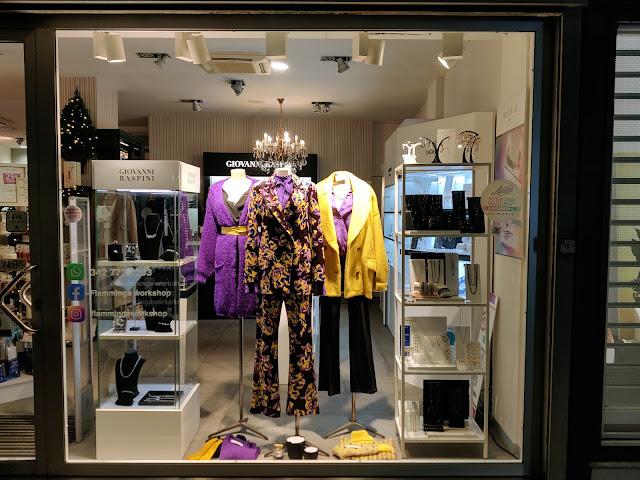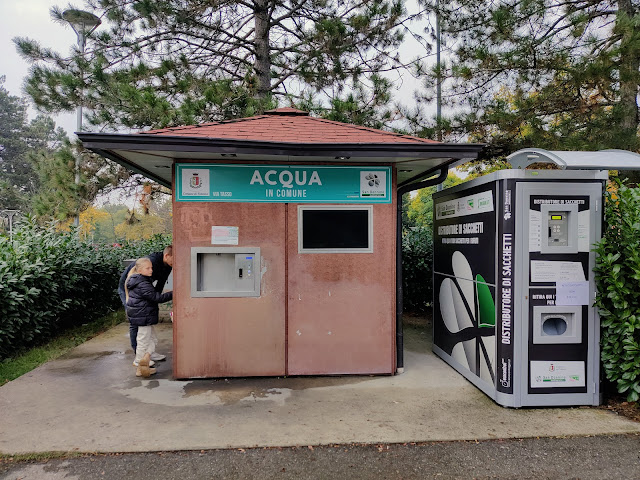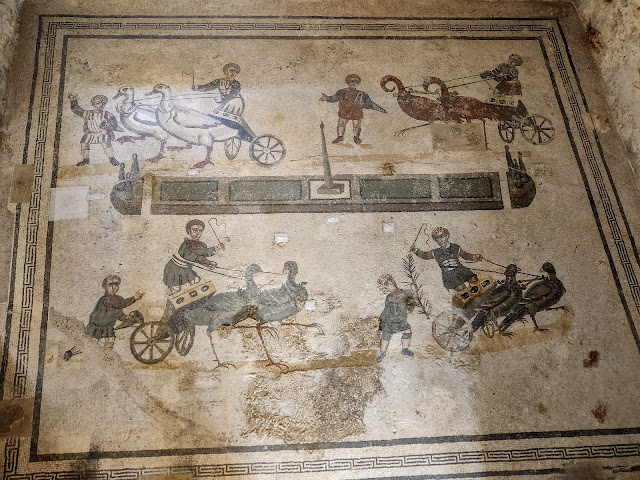We got back to Fidenza on Thursday afternoon, greeted by warm sunshine and shiny-clean streets. The annual San Donnino festival had finished the weekend before, and by the time we got here all evidence of the crowds, the food stalls, and the late-night carousing had been scrubbed away.
As ever, I arrived with a mental roster of things I wanted to be sure to do while I'm here. At the top of our list was eating at Bar Teatro, so we hurried over at lunchtime on Friday. The place was fully booked--I guess everyone else has figured out how great Angelo's cooking is--but luckily for us one customer was a fast eater and left a table empty that we were happy to grab. Danny had a veal chop with carrots and green beans and a salad of red cabbage and mache, while I, fighting to stay awake, opted for my favorite comfort food, pasta with a meaty tomato sauce. And a glass of fizzy red wine to help me get to sleep, because the next thing on my agenda was a nap. The pasta, the wine, and the nap were all delicious.

Another thing on my list was clearing out our pantry shelves. Last July I'd noticed that we'd been invaded by cupboard moths, and now when I looked over our food supplies I could see they'd been busy eating and breeding the whole time we were gone. Some open bags of flour, nuts, and other comestibles we'd neglected to put in the refrigerator before we left now were the cupboard-moth equivalent of Bar Teatro--a great place to get a good meal. So this afternoon I took everything off the shelves, washed off the legions of dead moths (and hopefully a lot of moth eggs), threw away everything that looked to be infested, and put the rest back in sealed containers and in good order. If the moths turn up again I'll know I missed something.
A third thing I've wanted to do is make a bollito misto. I've written before (here, for example) about restaurants in the area that specialize in this classic meal of boiled beef, tongue, chicken, sausage, and other meats. It's a feast-day dinner; recipes often start by saying "Serves 10" and calling for a whole tongue, a six-pound cut of beef, a calf's head, and so on. It's not something you'd think of making for yourself and your husband, no matter how much of a meat enthusiast he might be.
But ever since we started coming here I've been intrigued by the little DIY bollito misto kits at our local supermarket. The package includes a thick slice of raw tongue, a bony piece of beef, and a quarter of a capon, plus half an onion, a carrot, and a stalk of celery. (In Italian they call a celery stalk a gamba, a leg. Isn't that cute?) The label says "for broth" but I can't imagine that a thrify Italian housewife would toss away the meats after they'd been cooked.
Yesterday when we went to the market Danny got a turkey thigh--that was on his wish list--and I grabbed one of these bollito packages. This morning we followed up with a visit to the big Saturday street market, where we loaded ourselves down with parsley, cabbage, onions, carrots, and various other necessities, four bagsful altogether.
 |
| Danny took this photo. Thank you, dear! |
Inspired, this afternoon I started a minestrone in the InstaPot, looked through the bollito misto recipes in our various cookbooks, and then put the bollito meats on the stove to simmer with the recommended rosemary and parsley while I did battle with the cupboard moths.
Once the pantry cupboards were cleaned up I followed another recipe for a classic bollito accompaniment, a sauce of parsley, garlic, anchovies, breadcrumbs, and olive oil.
At last the meats were done (or as done as they were ever going to get--the capon was still weirdly rubbery after more than two hours of simmering). I extracted them and added some vegetables and pasta to the broth. Traditionally the brodo is clarified and served with anolini or other filled pasta, as a very refined first course. But we had a lot of veg filling up our fridge and I'd been made aware of just how much dry pasta we've got stockpiled, so I opted for a vegetable soup with whole-wheat farfalle instead.

Then came the main course. We'd bought some mostarda di frutta (very sweet candied fruit spiked with hot mustard oil) and a pepper relish to go with the bollito, along with the green sauce I'd made.
Here's our dinner. From the top, there's a mostarda peach and cherry, the green sauce, a slice of tongue, several pieces of boiled beef with some of the capon in the middle, and the pickle relish. It was a wonderful meal; even my critical husband said so. The meats on their own are pretty bland, but when they're eaten with the various relishes the plate really sings. I'm exhausted but very pleased with myself.
What's next on my list? A visit to an art show at the town's exhibition space (formerly a high school and, before that, Fidenza's fascist headquarters), some blog posts about vending machines, fascists, and greeting cards, and an investigation into making this blog's subscription doohicky finally work. There's a Roman-cuisine restaurant I'd like to try, in addition to going back to our old favorites. I want to see my Fidenza friends and get my Italian up to speed. Most of all, I hope to spend some time just enjoying being here. I'd be crazy not to.




































































